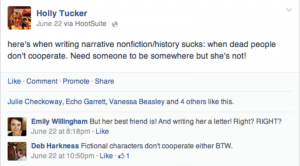 Another week has flown by—as weeks often do when I’m in the thick of writing.
Another week has flown by—as weeks often do when I’m in the thick of writing.
It’s a solitary process sometimes. I realized the other day that I had gone nearly 24 hours without real, live human contact. At least, not contact with living, breathing human beings.
Most of the people I hang out with these days are long gone. They speak only through manuscripts, memoirs, and court records. I pour over these documents for hours at a time. Sometimes I close my eyes and try to hear their voices.
What helps most are the tiny details, especially the most insignificant ones, told in passing by an observer or confessed in a letter. They are precious treasures that allow me to paint rich portraits in my writing. One person limps slightly after a horseback riding accident as a child. Another is plump and dowdy-looking. Then there is one who sweats profusely, especially when bedding women. (No kidding.)
While these details do not often impact how history unfolds, they let me view the people who inhabit the past for what they were: People, like you, like me. Each is an individual, with hopes, fears, hubris, and insecurities.
And each has the distinct and unique ability to frustrate the hell out of me.
Rules for Writing Past Lives
“There are only two rules specific to nonfiction,” Steven Pyne explains in Voice and Vision: A Guide to Writing History and Other Serious Nonfiction. “The rules are nonnegotiable: you can’t make anything up, and you can’t leave out something that really matters.”
I live by these rules. And that’s what made this week a challenge.
One person simply refused to be where I needed her to be. In fact, I had written several pages around the fact that she was where I thought she was. But she wasn’t. Or at least I couldn’t be sure she was. I came across a source that called everything in question. Fast forward: after several hours of research, I realized that I had to pitch not only those pages, I also had to restructure the organization of not one, but two earlier chapters.
Joining the Club
It would be fair to say that, as I research and write this book, I often get jealous of novelists. They get to make their stuff up, right?
But any novelist will tell you that that their characters can actually be a bossy bunch. Characters tell you what they need to be doing, when they want to do it, and why. They’ll also withhold secrets. (My friend and former W&M contributor, Tracy Barrett, told some great stories about this at her book launch this past week.)
So back to the person who annoyed the heck out of me last week. I did what any procrastinating author does. I took my complaint to Facebook. (Would love to see more W&M folks there by the way. Shoot me a friend request.)
I love that fellow historian Deborah Harkness chimed in. Harkness is a nonfiction writer and a New York Times bestselling novelist. (We featured the first two books in the All Soul’s Trilogy here. Watch for W&M coverage on the third next month.) Misery loves company.
Killing Them Off
Here’s where writing has its own perverse joys. By a lovely coincidence, my annoying person ends up meeting her end a few years later. And fortunately, it’s important to the story.
So it was not without some relief that she had to go. She was poisoned. It was slow, and it was horrible. Still, I felt very sad for the woman—even if she had been such a pain for me earlier in the week. She was a real person, and her suffering was also very real.
Still, she is probably fortunate that Tracy Barrett wasn’t writing her death…
Send Me Your Questions!
A big thanks to Jason, whose question in last week’s column inspired this post. I’ll be dropping you an email to see what book we can send you from the W&M stash to say thanks!
The characters in Blood Work are so real- is there one in particular who you feel like you know? How did the archives help with that?
I look forward to reading more questions in the Comments and via Twitter for next week — and, remember, whoever I feature in next week’s Editor’s Corner will also get a hand-selected a book from the W&M stash!


